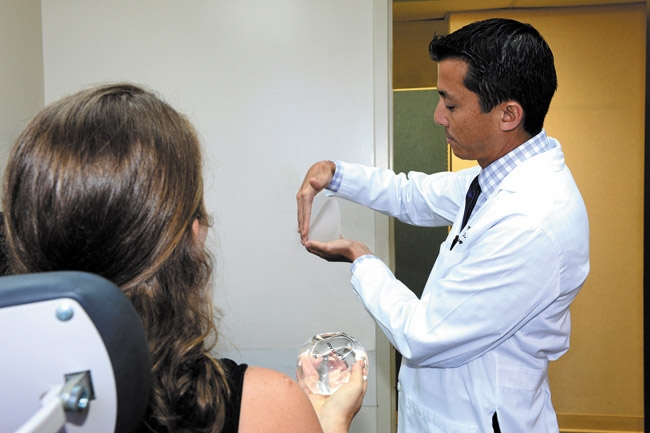Palate And Breast Reconstruction
Dr. David Cho
Plastic surgeon at Straub Hospital
Where did you receive your schooling/training?
I grew up in California. I went to college at UC-San Diego and stayed there for medical school. After that, I went to Loma Linda University in Southern California for plastic surgery residency. After six years there, I did a one-year fellowship in pediatric plastic surgery in Toronto.
mw-dih-dr-davidcho-2
How long have you been in practice?
Three and a half years. My practice here at Straub is adult and pediatrics. I do a wide variety of cases. Part of the attraction of plastic surgery for me was the variety.
You do reconstructive surgery, and you had a cleft lip yourself. Is that what inspired you to go into the field?
That’s how I was first introduced to the field. My parents encouraged me to learn more about plastic surgery when I was a kid. I actually wanted to be a plastic surgeon in Hawaii from as early as grammar school. I remember telling my grandmother, who lived in Alewa Heights, that I wanted to be a plastic surgeon on Oahu and live on the North Shore. Most of it came true, except that I don’t live on the North Shore.
What reconstructive surgery do you specialize in?
I do quite a bit of breast cancer reconstruction both at Straub and Kapiolani. I do every variety of reconstructive surgery and every variety of cosmetic surgery. Regarding reconstructive surgery, at Straub we’re known for our burn unit. We have the only burn unit in the Pacific. We take care of any major burn in this hospital, and that may involve skin grafting.
Is cleft palate something you want to address in a child as soon as possible?
It depends which surgery is being done. For a cleft lip repair there’s no exact timeline, but it’s typically done after 3 months of age. That’s done to make the family feel better, but there’s no functional reason why it has to be done right away. In contrast, cleft palate surgery should be done at approximately 9 months of age, and certainly before 1 year of age, because you want to prioritize speech abilities. If you repair the palate before 1 year of age, theoretically you should have a better speech outcome.
How much of the roof of the mouth does a cleft palate involve?
There’s a hard part and as it goes farther back in the mouth, it becomes soft. Eventually you see the uvula, the thing that hangs down. All of that can be separated, and then it’s a cleft palate. Some people use palate to mean both lip and palate, but it’s better to distinguish lip versus palate.
Is cleft palate or cleft lip congenital?
It’s multifactorial. One of the factors is family history, but there are also environmental reasons. And then there’s unknown reasons.
Family history is a significant one.
For breast reconstruction, is that generally reshaping the breast after cancer surgery?
Advances in mastectomy, or breast removal techniques, have made it possible to preserve much of the skin and sometimes even to preserve the nipple or areola. In those situations, I’m providing volume to re-expand the breast, but I’m not introducing any new skin. The new volume that gets introduced could be in the form of implants, saline or silicone, or it can be in the form of a flap, which is using the patient’s own tissue, for example, from their abdominal area or their back area, to reconstruct the breast mound.
The nipple is typically made by using the available skin on the breast. The areola is often tattooed, and that can usually be done as an outpatient procedure in a quick amount of time. We do our own tattooing.
Anything you’d like to add?
We do a lot of cosmetic surgery. A lot of us plastic surgeons like this field because we get to do diverse types of procedures and we work with diverse patient demographics. A lot of people don’t realize that cosmetic surgery complements reconstructive, and reconstructive complements cosmetic surgery. For example, a lot of the advances we have in breast reconstruction for women with breast cancer come from advances in technology that were meant for breast augmentation in the cosmetic world, and vice versa. Things like reconstructing a kid’s cleft lip comes from principles that also were identified in the aesthetic world. If you’re able to do both types of procedures in your practice, it can make you a better plastic surgeon.
One thing people find interesting is that I’ve been on lots of international trips to do free reconstructive surgery for cleft palate patients. I’ve been to Baja, Mexico, mainland Mexico, the Dominican Republic and Ethiopia. It’s a refreshing way to practice medicine because there’s no paperwork, no billing, no insurance company. You get to do medicine in its purest form, which is why doctors go into it in the first place.
As a child, I had a goal to be a plastic surgeon, but during my college days I got a bit distracted and I had aspirations to be a National Geographic photographer and artist. I always loved painting, drawing, sculpture and photography, but after working as a photo editor for a newspaper, I thought I’d make better use of my talents if I could be a plastic surgeon, especially since I had received plastic surgery myself. So I went back into the field.
Many of the procedures are artistic, and that’s something I like about it.






